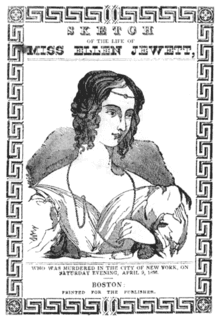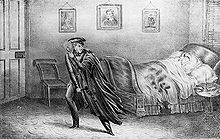- Helen Jewett
-
Helen Jewett (October 18, 1813 – April 10, 1836) was an upscale New York City prostitute whose murder, along with the subsequent trial and acquittal of her alleged killer, Richard P. Robinson, generated an unprecedented amount of media coverage.
Contents
Early history
Jewett was born Dorcas Doyen[1] in Temple, Maine, into a working class family. Her father was an alcoholic; her mother died when Jewett was young. From the age of 12 or 13 Jewett was employed as a servant girl in the home of Chief Justice Nathan Weston of the Maine Supreme Judicial Court. While there, she developed into a sexually assertive young woman, and upon reaching the age of 18 left the Weston home at the first opportunity. She moved to Portland, Maine, where she worked as prostitute under an assumed name (a standard practice at the time). She subsequently moved to Boston and finally New York under a succession of fake names.
The murder
Jewett's body was discovered by the matron of the brothel, Rosina Townsend, at 3 a.m. on April 10, 1836. The murder had taken place sometime after midnight. Jewett was struck on the head three times with a sharp object. (The coroner's report called it a 'hatchett'.) Based on the position of the corpse in bed, the coroner concluded that the blows were not expected: there were no signs of struggle. After inflicting the lethal blows, the murderer then set fire to Jewett's bed. Townsend discovered the room full of smoke, and Jewett's body charred on one side.
The trial
Based on the testimony of the women who lived in the brothel, the police arrested 19 year old Richard P. Robinson on suspicion of Jewett's murder. Robinson, a repeat customer of the victim, flatly denied killing her, and did not display much emotion even when confronted with the still warm corpse. Nevertheless, based on the testimony of various witnesses and the recovery of a cloak that resembled Robinson's, the coroner's jury, hastily assembled on the scene and made up of on-lookers, concluded that Jewett met her end "by blows ... inflicted ... with a hatchett by the hand of Richard P. Robinson." This was enough to gain an initial indictment.
On June 2, 1836, Robinson's trial for murder began. Ex-D.A. of New York Ogden Hoffman appeared for the defence. After days of testimony from several witnesses, including Rosina Townsend, the judge gave the jury its instructions. As most of the evidence against Robinson was circumstantial, the jury returned with a verdict of not guilty in less than a half hour.
However, as most of the witnesses were other prostitutes, the judge ordered his jury to disregard their testimony.
The press
Jewett's murder excited the press and the public. The coverage of the murder and trial was highly polarized, with reporters either sympathizing with Jewett and vilifying Robinson or attacking Jewett as a seductress who, according to nineteenth century standards, deserved her fate. The New York Herald, edited by James Gordon Bennett, Sr., provided the most complete (if not unbiased) coverage of the sensational murder. Almost from the beginning and throughout the trial, Bennett insisted that Robinson was the innocent victim of a vicious conspiracy launched by the police and Jewett's madam. He also emphasized the sensational nature of the story and worked to exploit the sexual, violent details of Jewett's death. The New York Sun, on the other hand, whose readers tended to come from the working class, argued that Robinson was guilty and that he was able to use money and the influence of wealthy relatives and his employer to buy an acquittal.
Post Trial
Personal letters of Robinson's that became public after the trial undercut some of his claims and showed him to be capable of vicious and (for the time) deviant sexual behavior. The public turned on him, including some who had been his vocal supporters, as his guilt became clear. Robinson eventually moved to Texas where he became a respected frontier citizen.
References in popular culture
Jewett's death forms part of the plot of the novel Burr by Gore Vidal.
References
- ^ The trial of Richard P. Robinson for the murder of Helen Jewett. New York City, 1836 In : American state trials / John D.Lawson, editor pp 426-487 Wilmington, Del. : Scholarly Resources, 1972
- Patricia Cline Cohen, The Mystery of Helen Jewett:Romantic Fiction and the Eroticization of Violence, 17 Legal Studies Forum 2 (1993)
- Patricia Cline Cohen, The Murder of Helen Jewett. New York: Alfred A. Knopf, 1998
- http://www.crimelibrary.com/notorious_murders/classics/helen_jewett/index.html
- Timothy J. Gilfoyle, City of Eros: New York City, Prostitution, and the Commercialization of Sex, 1790-1920. New York: W.W. Norton, 1992
- Andie Tucher, Froth and Scum: Truth, Beauty, Goodness, and the Ax Murder in America's First Mass Medium. Chapel Hill: University of North Carolina Press, 1994.
Categories:- 1813 births
- 1836 deaths
- American prostitutes
- American murder victims
- Crimes against sex workers
- People from Franklin County, Maine
- People murdered in New York
- Deaths by blade weapons
Wikimedia Foundation. 2010.


